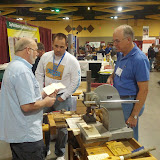routers and this one was on the list.

 I cant remember what this is called but it is used for routing end grain and smaller pieces. This one is made out of metal whereas the Ryobi one was made out of plastic.
I cant remember what this is called but it is used for routing end grain and smaller pieces. This one is made out of metal whereas the Ryobi one was made out of plastic.






Senin, 04 April 2016
Woodworking Bench II My Bench Now and Future
 |
My Current Workbench |
 |
Shaker Style Woodworking Bench |
 |
Tail Vice |





























